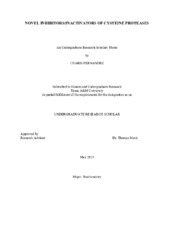| dc.description.abstract | When operating aberrantly, enzymes contribute to the mechanisms of many different diseases, and as such, have proven to be promising targets for the discovery of new drugs. Proteases catalyze the hydrolysis of peptide bonds and proteins, the result of which is the inactivation or de-activation of physiological processes that are often contributory to disease. The cysteine proteases are also involved in pathogenesis including cancer, autosomal disorders, pulmonary disorders, and their action assists in the infectivity of the pathogenic protozoa that cause Chagas’s disease and malaria. Despite their importance as therapeutic targets, currently no inhibitors of cysteine proteases have proven viable as treatments for these diseases. While numerous inhibitors of cysteine proteases exist, most of which inactivate these enzymes by covalent reaction, none have to date proven sufficiently specific to serve as drugs. We are beginning to develop novel types of covalent inactivators, which utilize detailed aspects of the mechanism and structure of cysteine proteases to render them highly selective toward their targets. The cysteine proteases human cathepsin C and cathepsin L were used as models to develop new inhibitors because they are available, well characterized kinetically, and the structure of human cathepsin C has been fully determined. This model served as a means to apply the same chemistry or similar to other enzymes such as falcipain-2, a drug target for malaria. Falcipain-2 was prepared as a recombinant protein. Three compounds, Cbz-Phe-Phe-CHO, Cbz-Phe-Phe-vinyl-phenylsulfone (Cbz-Phe-Phe-VSPh), and Cbz-Phe-Phe-2-vinylpyrimidine (Cbz-Phe-Phe-2VP), were shown to be time-dependent inhibitors/inactivators of falcipain-2 with apparent values of Ki = 0.25 nM, 32 nM, and 70 nM, respectively. Cbz-Phe-Phe-VSPh was a clinical candidate for treatment of malaria, but failed because it lacked sufficient specificity for falcipain-2. It does serve, however, as a “benchmark” inactivator for comparison with our novel inactivator Cbz-Phe-Phe-2VP. This inactivator has a pyrimidine ring that allows for “tuning” of its electrophilicity to create different levels of specificity. An increase in specificity for falcipain-2 could result in a decrease in side effects and more targeted clinical applications for treatment of malaria. | en |


